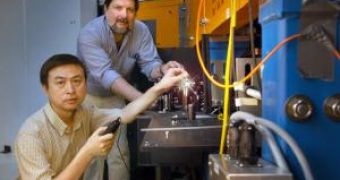A group of researchers has recently generated extremely short pulses of light that are the strongest of their type ever produced. By using these pulses, they can take a peak at the incredibly fast-paced nanoworld, of atoms and electrons.
Lead author Yuzhen Shen and NSLS researcher Larry Carr, at the U.S. Department of Energy's Brookhaven National Laboratory, also performed the first observations of a phenomenon called cross-phase modulation with this high-intensity light, a phenomenon that could find practical applications in numerous new light source technologies.
The pulses they were able to generate were in the terahertz (THz) range of the broad electromagnetic spectrum, an extremely frequency, from 30 to 300 gigahertz, having a wavelength below one millimeter. Researchers send tight bunches of electrons at nearly the speed of light through a magnetic field to produce this radiation, a longtime goal for scientists in the field.
"The goal is really to understand the properties of materials," said Shen. "One might ask what happens in a solid when light, electricity, or sound goes through it, and it's all related to atoms in a crystal wiggling around or the movement of electrons. So the effort surrounding ultra-fast pulses is going into making tools to probe the real fundamental properties of materials on the scales at which they move."
While performing the experiment, they also detected a phenomenon known as cross-phase modulation, which has strange effects on materials, like changing the color of the light or turning the material into a focusing lens.
This is the first time cross-phase modulation that has been observed in single-cycle THz pulses. Learning how to control this characteristic could lead to even more light source technologies and even JPL and NASA are interested in the technology, since the applications have high commercial and scientific value.

 14 DAY TRIAL //
14 DAY TRIAL //